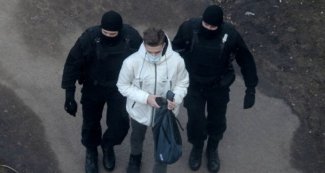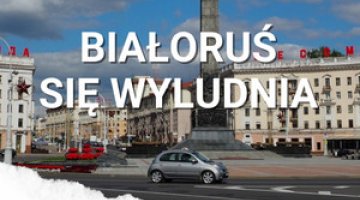Belarus is intimidated – the failure of the Freedom Day celebrations

This year Freedom Day, which the opposition commemorates on 25 March (the anniversary of the proclamation of the Belarusian People’s Republic in 1918) and which is not recognised by the Belarusian regime, was feted without a single large demonstration held by the opponents of Alyaksandr Lukashenka. In several places huge white-red flags were hung on buildings and in the evening rather small firework displays were held in some parts of several cities (including Minsk, Hrodna and Vawkavysk). There were not any larger gatherings organised on Saturday 27 March either. Opponents of the regime declared it the main celebration day, a public holiday of street activity of rebellious citizens.
The Minsk municipality rejected the motion submitted by several opposition groups (among them the ‘For Freedom’ Movement) to commemorate Freedom Day legally due to ‘radical inclinations of the organisers’ and the epidemiological threat. The majority of Belarusians adopted a passive attitude despite appeals from opposition leaders who have emigrated, Sviatlana Tsikhanouskaya and Pavel Latushka, and announcements which were published in popular social media channels and suggested several options to demonstrate opposition to the Belarusian government. The vote, which was held online on 18 March regarding the proposal to hold talks between Tsikhanouskaya and the regime in order to ensure a peaceful transition of power, did not mobilise Belarusians to join protests either. This proposal was supported by nearly 760,000 citizens (out of 769,000 of those who took part in the vote).
For more than ten days in the run up to 25 March, the Belarusian law enforcement forces sent a series of signals that they were fully ready to firmly prevent the opposition from allegedly seeking to ‘provoke radical street gatherings’, aimed at destabilising Belarus’s internal situation (this included the head of the State Security Committee of the Republic of Belarus (KGB), in a special television interview). While justifying recent personnel changes in the law enforcement sectors and in the army (on 11 March), Lukashenka emphasised that the main opponent to the Belarusian armed forces was the ‘internal enemy’, seeking to dismantle the present legal system. On 26 March, the Ministry of Internal Affairs of Belarus reported that a man had been arrested for allegedly preparing two terrorist attacks (one in Minsk and the other outside it). It was alleged that the attacks were commissioned by an emigrant organisation BYPOL, established by former law enforcement functionaries. In order to further intimidate potential protesters ahead of 25 March many heavily equipped law enforcement forces (mainly OMON and the internal troops of the Ministry of Internal Affairs) were placed in the centre of the capital.
Despite little activity from protesters on 25 and 27 March, the police detained both random passers-by and people suspected of the intention to join a demonstration. In total, over 400 people have been arrested in recent days. Some of them have already been sentenced to detention of up to 15 days and the others were released after their identity had been checked.
Commentary
- The lack of mass street protests in Belarus is above all the effect of a huge wave of repression which has been underway for the last few months – hundreds of people have been sentenced to long prison sentences (usually from two to five years) for having participated in demonstrations held in 2020. Similarly, even the smallest manifestations of dissent, such as wearing white and red clothes or hanging illegal symbols in the windows of private flats, have been severely punished. Journalists, social activists and human rights defenders have also been targeted with repression and this has been accompanied by intensive propaganda in the state-owned media. These measures are aimed at intimidating Belarusian society and have so far proved rather effective in almost completely demobilising the resistance movement as regards the date of 25 March (which is symbolic for opponents of the Belarusian regime). However, the low level of engagement of Belarusians in the protests (it was the lowest on record for Freedom Day) does not stem from changes in their political preferences since most of them still expect Lukashenka to step down from the presidency which they believe he has been holding illegally following the rigged presidential election held on 9 August 2020.
- The lack of demonstrations also means failure for the opposition leaders. They had announced a ‘second wave’ of protests, following a decline in the dynamics of street protests in winter. The announced mobilisation on the streets (which has been described as a ‘hot spring’ by some media organisations) was intended to demonstrate the high mobilisation potential of the opposition and to provide a political advantage for its leaders in their possible talks with the government (Tsikhanouskaya was among those who underlined this, on 18 March). However, not only were the leaders of the demonstrations unable to encourage their supporters to participate in risky street protests but also to take part in online voting en masse, which seemed the safest form of expressing an opinion. It is worth noting that the number of the votes cast is so far 200,000 lower than the result Tsikhanouskaya obtained in the online vote for presidential candidates held on the same internet platform in summer 2020. That vote was an alternative to the official one and Tsikhanouskaya won it. This may mean that, even though many of Lukashenka’s opponents have been intimidated, some of them are also disappointed with the lack of outcomes of the mass post-election protests held in summer and autumn 2020 and the ineffective actions undertaken by the opposition leaders, who are deprived of a genuine impact on the situation in the country.
- The lack of protests between 25 and 27 March is a great success for the Belarusian regime and it will be used for propaganda purposes. It should be expected that the repression will not only continue (as an effective means to subdue Belarusian society) but will escalate. The repression will be used to completely discredit Belarusian democratic circles (portrayed as a group of radicals and terrorists) and to take full control of the internal situation in the country. Nevertheless, it should be stressed that the dissatisfaction of Belarusian citizens has only been muffled in its external manifestations while the causes of it have not been eliminated. Thus the large-scale outrage present in society will again present the risk of another rebellion which may get out of the control not only of the regime but also of the opposition leaders outside the country.




